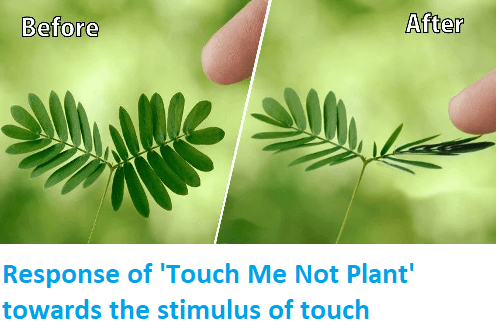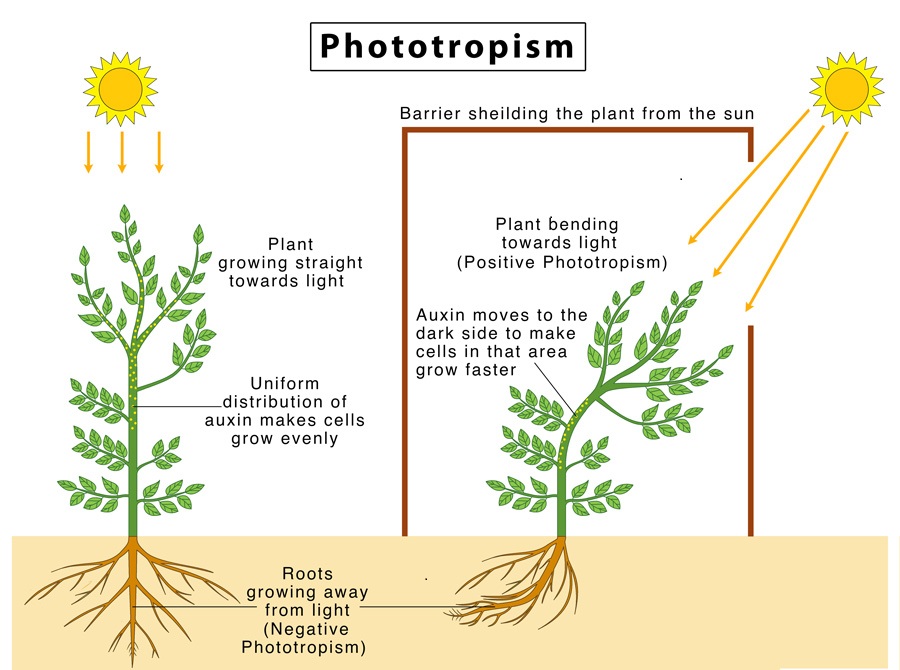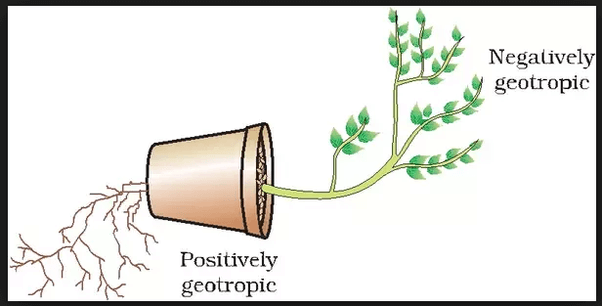 | e-NOTES (2134 [C] ) | ||||||||||||
| 10th (Biology) | |||||||||||||
| Control And Coordination II | |||||||||||||
Response in Plants or Turgor MovementsPlants do not have nervous system or muscle tissue like animals, but they still show movement and response. This is because they use chemical means to convey information from one cell to another. The ability of a plant to detect change and respond to the same is termed as “sensitivity of the plant”. The movement of plants is broadly classified into two types; Autonomic and Paratonic. | |||||||||||||
Immediate Response to Stimulus in PlantsLike all other organisms plants also show response to changes occurring in environment. Plants respond to these changes or stimulus by showing different type of movements. These movements can be growth movements or nastic movements. Growth movements help the plant to grow whereas nastic movement do not perform any such kind of function. Nastic movements show immediate respond to a stimulus. Immediate response to stimulus does not involve any growth, rather plant moves its leaves in response to touch. Sensitive plants give immediate response to the stimulus. Movement of part of plant occurs at a point different from the point of touch. Plant communicates the information that a touch has occurred. This is done in the following: a) Plants use electro-chemical means to convey the information from cell to cell as there are no specialized tissue for the conduction of information. b) Plant cells change their shape by changing the amount of water in them, resulting in either swelling or shrinking of cell and finally in shape. | |||||||||||||
Movement due to Growth in PlantsMovement due to growth: Plants respond to stimuli by growing in a particular direction. This growth is directional due to which the plant appears moving. Some plants like pea, pumpkin and cucumber plant climb up on other plants or fences by means of tendrils, which are sensitive to touch. When these tendrils come in contact with any support, the part of tendril in contact with the object does not grow as rapidly as the part of the tendril away from the object. This causes the tendril to circle around the object and thus, cling to it. There are two types of movements shown by plants: Tropic movement and Nastic movements
| |||||||||||||
Nastic MovementsQuick Movements of Plants or Nastic MovementRapid movements are uncommon in plants, but some plants do display such movements in response to stimuli. Touch the tip of a sensitive plant (Mimosa pudica) gently. Only a few leaflets close. When you touch it roughly, all the leaflets close. In Mimosa pudica (touch me not plant), the leaflets fold up quickly if any leaflet is touched. How does it happen? It happens because the touch triggers a sudden and rapid loss of water (turgor changes) from cells at the base of the leaflets. These movements of sensitive plants in response to touch are very quick. All quick movements are not so quick. For example, the leaves of many plants, including those of Mimosa pudica, remain open during day. When darkness falls, the leaves fold up. Many flowers open after sunrise and close after sunset. All these movements are directed neither towards nor away from the stimulus. Such movements are called Nastic Movements. Types of Nastic Movements: | |||||||||||||
Stomatal MovementsStomata are the tiny pores present on the outer surface or epidermis of the leaves and in some cases also on the stem. These pores help in the exchange of gases,transpiration and photosynthesis. The opening and closing of stomata is controlled by Abscisic acid hormone. Structure of StomataA stomata is consist of subsidiary cells, Guard cells and stomatal aperture. Subsidiary cells are the cells that surrounds the guard cells.Based on the number of subsidiary cells stomata can be of different types. Guard cells are bean shaped cells that surrounds the stomatal aperture. These cells regulate the closing and opening of stomata. Stomatal aperture is a tiny pore present on the surface through which exchange of material takes place. Functions of Stomata | |||||||||||||
Growth or Tropic MovementsThe movement of an organism in the direction of a stimulus or away from it is called tropic movement, or tropism. A tropic movement is said to be positive if it is directed towards the source of stimulus and negative if directed away from the source of stimulus. The plant responds by growth or turgor changes, so that parts of the plant bend towards or away from the direction of stimulus. Tropic movements are of different types in response to different stimuli. Growth-related movement of plants is quite slow. Different types of tropic movements: | |||||||||||||
Phototropism MovementIt is the tropic response of organisms to light. When a young green plant receives light from one direction only, the stem grows towards the light source. The stem is said to be positively phototropic because the stem tip grows in the direction of light. Sunflower buds exhibit a special type of phototropism in which the buds turn slowly through the day so that they always face the sun. This movement is caused by turgor changes. How phototropism occurs ? It is the directional movement of a plant in response to light. The shoot responds by bending towards light and roots respond by bending away from light. This happens as; a. When sunlight falls straight on the plant, the auxin hormone synthesized at the tip of the stem spreads uniformly down the stem and due to equal concentration of auxin, stem grows straight. b. When sunlight falls on only one side of the plant, the auxin diffuses towards the shady side of shoot. The concentration of auxin stimulates the cells to grow longer. Therefore, the stem appears to bend towards the source of light. | |||||||||||||
Geotropism MovementGeotropism is the tropic response of organisms due to gravity. When a growing portion of a plant is placed horizontally, the stem tip grows away from the pull of gravity, while the root tip grows towards it. Thus, the stem is said to be negatively geotropic and the root positively geotropic. The hydrotropic movements are more stronger then the Geotropic movement therefore the roots will grow inside the soil in the direction of water available. Example : Place a potted plant horizontally on the ground. After a week, you will see that the stem has bent upwards to grow away from gravity. And if you break the pot and remove some of the soil gently, you will notice that the root has bent downwards to grow in the direction of the pull of gravity. | |||||||||||||
Hydrotropism MovementThe growth of plant parts towards or away from water is called hydrotropism. Roots are positively hydrotropic, i.e., they grow towards water in the soil. The positive hydrotropism of roots is stronger than their positive geotropism .Due to hydrotropism, the roots of roadside trees often block leaking sewage drains. The growth of stem away from the water is an example of negative hydrotropism. Experiment :We take two glass troughs A and B and fill each one of them two -third with soil. In trough A we plant a tiny seedling. In trough B we plant a similar seedling and also place a similar seedling and also place a 'clay pot' inside the soil. Water the soil in trough A daily and uniformly. Do not water the soil in trough B but put some water in the clay pot buried in the soil. Leave both the troughs for a few days. Now, dig up the seedlings carefully from the both troughs without damaging their roots. We will find that the root of seedling in trough A is straight. On the other hand, the root of seedling in trough B is found to bend to the right side. Conclusion :In trough A, the root of seedling gets water from both sides. But in trough B, the root gets water oozing out from the clay pot which is kept on the right side. This experiment shows that the root of a plant grows towards water. In other words,the roots of a plant id positively hydrotropic. | |||||||||||||
Chemotropism MovementThe tropic response of organisms to chemicals is known as chemotropism. It is best seen in the growth of pollen tube inside the style, ovary and ovule. Here every region produces its own nutrients and chemotactic chemicals for growth and passage of pollen tube. Chemotropism can be observed by germinating a number of pollen grains in animal medium. A drop of nutrient medium containing boron will result in bending of pollen tubes towards it from all directions. | |||||||||||||
Thigmotropism MovementThe tropic response of organisms to touch or contact with a solid surface is called thigmotropism. It can be positive and negative based on response of plant part towards the stimulus of touch. Examples : The climbing parts of a plant that twine around a support are positively thigmotropic. When such a plant part touches a support, the side of its apical meristem in contact with the support grows slower than the other side. This is how tendrils coil around a support. A negative thigmotropism is a response away from the touch stimulus. An example of negative thigmotropism is the growth of roots underneath the soil. When an elongating root comes in contact with an object, e.g. rock,it grows away from the object. | |||||||||||||
Plant HormonesResponses and growth in plants are controlled by chemical substances called plant hormones, or phytohormones. These substances are found in very minute quantities in plant tissues. A hormone is produced in specific cells of the plant and is transferred to another part where it influences a specific physiological process. While some plant hormones such as auxins, gibberellins and cytokinins stimulate growth, some others such as abscisic acid retard it. These hormones are produced in almost all parts of the plant and are transmitted to various parts of the plant. They may act synergistically or individually. Roles of different hormones can be complementary or antagonistic. Hormones play an important role in the processes like vernalisation, phototropism, seed germination,dormancy etc. along with intrinsic factors.Plant hormones control directional growth in plants and also bring about growth in carefully controlled ways. For example, they help plants to grow leaves only at the nodes and not at other parts of the body. | |||||||||||||
AuxinsAuxins: Auxins are the first hormones to discovered. Auxins are a group of plant hormones synthesized in the apical meristem of the root tips and shoot tips. When a shoot tip receives light, the hormone auxin is synthesized and diffuses towards the shady side of the shoot. This leads to enhanced growth on this side. Thus, the plant bends towards the light. Function of auxin : | |||||||||||||
GibberellinsKurosawa, a Japanese botanist, discovered gibberellin while investing the rice foolish seedling disease in which spindly seedlings are formed due to GA like compounds produced by the fungus (Gibberella fujikuroi) infecting the plant. Gibberellins are group of growth promoters. The best known naturally occurring gibberellin is Gibberellic acid. Function of Gibberellins : | |||||||||||||
CytokininsCytokinins are chemicals which promote cytokinesis (cell division). They are produced in dividing cells throughout the plant. In mature plants, cytokinins are produced in the root tips and are transported to the shoots. Functions | |||||||||||||
Abscisic Acid And EthyleneAbscisic acid: Abscisic acid is a growth inhibitor that reverses the growth-promoting effects of auxins and gibberellins. It is also called as antigibberellins. It causes dormancy of seeds, tubers and bulbs. It promotes leaf and fruit fall. It helps in the closure of the stomata to decrease the loss of water or reduce transpiration. Ethylene : Ethylene is a gaseous hormone that acts at trace levels throughout the life of the plant. It is also known as ripening hormone. Ethylene also induces epinasty, leaf abscission,induces flowering in pine apples and checks the elongation in stem and root. However it promotes rooting like auxin. Functions of Ethylene: | |||||||||||||
 | |||||||||||||

Powered by ABHYAS ChatBOT.

What describes you best?

I am a Student
I am a Tutor
I am a School Owner
I want to appear for Govt. Exams

.png)




